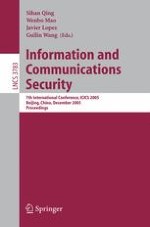The Seventh International Conference on Information and Communications - curity,ICICS2005,washeldinBeijing,China,10-13December2005. TheICICS conference series is an established forum for exchanging new research ideas and development results in the areas of information security and applied crypt- raphy. The ?rst event began here in Beijing in 1997. Since then the conference series has been interleaving its venues in China and the rest of the world: ICICS 1997 in Beijing, China; ICICS 1999 in Sydney, Australia; ICICS 2001 in Xi’an, China; ICICS 2002 in Singapore; ICICS 2003 in Hohhot City, China; and ICICS 2004 in Malaga, Spain. The conference proceedings of the past events have - ways been published by Springer in the Lecture Notes in Computer Science series, with volume numbers, respectively: LNCS 1334,LNCS 1726,LNCS 2229, LNCS 2513, LNCS 2836, and LNCS 3269. ICICS 2005 was sponsored by the Chinese Academy of Sciences (CAS); the Beijing Natural Science Foundation of China under Grant No. 4052016; the National Natural Science Foundation of China under Grants No. 60083007 and No. 60573042;the NationalGrandFundamentalResearch973ProgramofChina under Grant No. G1999035802, and Hewlett-Packard Laboratories, China. The conference was organized and hosted by the Engineering Research Center for Information Security Technology of the Chinese Academy of Sciences (ERCIST, CAS) in co-operation with the International Communications and Information Security Association (ICISA). The aim of the ICICS conference series has been to o?er the attendees the opportunity to discuss the latest developments in theoretical and practical - pects of information and communications security.
